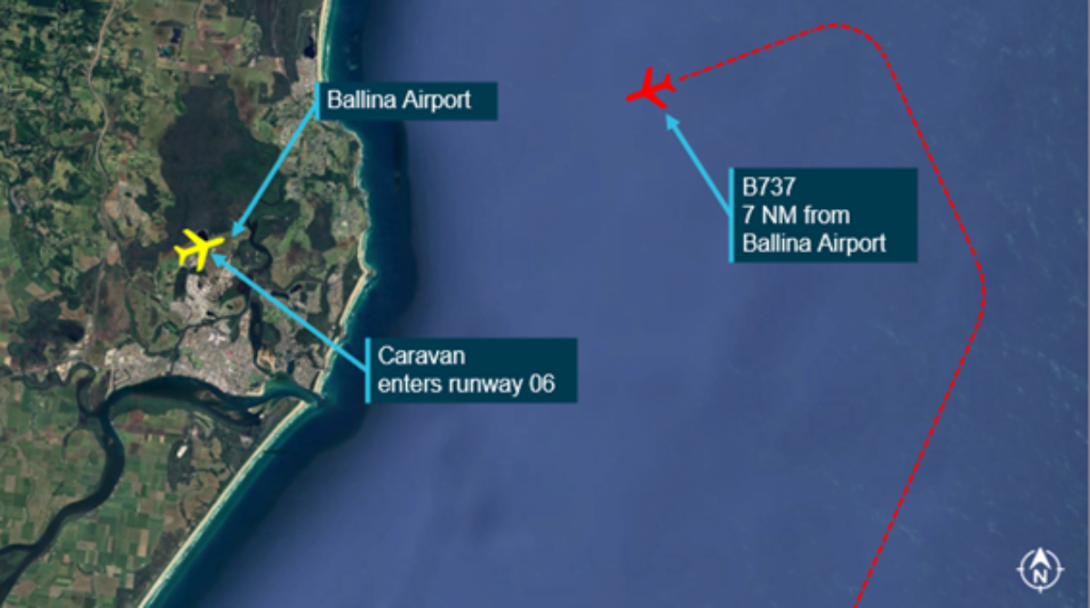
|
Key points
|
A Cessna Caravan pilot’s incorrect mental model was one of number of contributing factors that led to their aircraft taking off from Ballina Airport directly towards a Boeing 737 airliner that was on approach to land there, an Australian Transport Safety Bureau investigation details.
The incident occurred on the afternoon of 16 September 2021, when a Virgin Australia 737-800 was conducting a scheduled passenger service from Sydney to Ballina, and the Caravan was commencing a repositioning flight from Ballina to the Sunshine Coast. The Caravan had commenced its take-off roll from Ballina’s runway 06 to the east when the B737 was on final approach to land on the reciprocal runway 24 from the east.
The Caravan pilot’s radio call on the Ballina CTAF (common traffic advisory frequency – a designated radio frequency pilots use to make positional broadcasts in the vicinity of airports where there is no air traffic control tower and separation service) announcing they were entering the runway and commencing their take-off roll, was the first call the 737’s crew recalled hearing from the Caravan.
Neither the Caravan pilot, nor the surveillance flight information service (SFIS) controller – an air traffic controller based in Brisbane Centre who provided traffic information to aircraft operating in the Ballina CTAF – recalled hearing the 737 crew’s subsequent broadcast on the CTAF that they were on a 5 NM final approach.
In subsequent radio calls the crews of the two aircraft established communications with each other, with the Caravan pilot confirming they could see the B737, and the B737 requesting the Caravan commence a turn.
The Caravan pilot initiated a turn to the right shortly after becoming airborne, while the 737 crew commenced a missed approach (aborting the landing).
Shortly after, the 737 flight crew then sighted the Caravan ahead of their aircraft, flying in a northerly direction. They then received a traffic collision avoidance system (TCAS) traffic advisory generated by the Caravan’s proximity.
The 737 flight crew maintained visual contact with the Caravan and repositioned their aircraft for a left circuit to land on runway 24. The Caravan continued to the Sunshine Coast without further incident.
A review of recorded flight data indicated that separation between the two aircraft reduced to approximately 0.9 NM laterally and about 700 feet vertically, as the 737 was overhead the runway and the Caravan was climbing to the north.
“The ATSB’s investigation identified that the Caravan pilot had an incorrect mental model of the traffic scenario, believing the 737 would land behind them on runway 06, rather than runway 24,” said ATSB Director Transport Safety Stuart Macleod.
“The Caravan pilot had been provided with traffic information by the Ballina Airport surveillance flight information service controller, but the controller had not specified the landing direction of the 737 and the pilot had not sought this information.
“The scenario was further compounded by the flight crew of the 737 not hearing the initial communications from the Caravan pilot, or the SFIS controller's response, and the flight crew remained unaware of the Caravan until just prior to it entering the runway.”
The report also notes that the SFIS controller did not issue a safety alert as they were concerned that doing so would result in over transmitting communications between the 737 and Caravan.
“Safety around non-controlled airports is an area of focus for the ATSB, and this incident serves as a reminder of the importance of communicating with other aircraft on the common traffic advisory frequency, even when services such as a surveillance flight information service are provided,” Mr Macleod said.
“Additionally, pilots and controllers alike should ensure critical information is communicated and understood in order to maintain the accuracy of shared mental models.”
The Ballina SFIS was established on 12 August 2021, replacing the previous certified air/ground radio service (CA/GRS). The controller providing the SFIS utilises available ADS-B surveillance data and radio broadcasts on the airport’s CTAF to provide all aircraft with a full traffic information and alerting service. This includes information on conflicting traffic, but the controller does not provide a separation or sequencing service, with pilots remaining responsible for seeing and avoiding other aircraft.
“The ATSB also found that the SFIS had been implemented in an area with known surveillance coverage limitations,” Mr Macleod noted.
Airservices Australia has advised the ATSB that additional technology (a new ADS-B ground station) to improve surveillance coverage in the vicinity of Ballina Airport was scheduled for installation by 23 March 2023.
Separately, Mr Macleod noted that neither aircraft was equipped, and nor were they required to be, to receive and display ADS-B positional information on other aircraft.
“The ATSB strongly encourages the fitment of ADS‑B transmitting, receiving and display devices as they significantly assist pilots in the the identification and avoidance of conflicting traffic,” he concluded.
“The continuous positional information that ADS‑B provides can highlight a developing situation many minutes before it becomes hazardous – a significant improvement on both point‑in‑time radio traffic advice and ‘see‑and‑avoid’.”
ADS‑B receivers, suitable for use on aircraft operating under both the instrument or visual flight rules, are currently available within Australia at low cost and can be used in aircraft without any additional regulatory approval or expense.
Read the final report: Separation occurrence involving Boeing 737-8FE, VH-YIO and Cessna Caravan 208, VH-YMV Ballina Byron Gateway Airport, New South Wales on 16 September 2021


